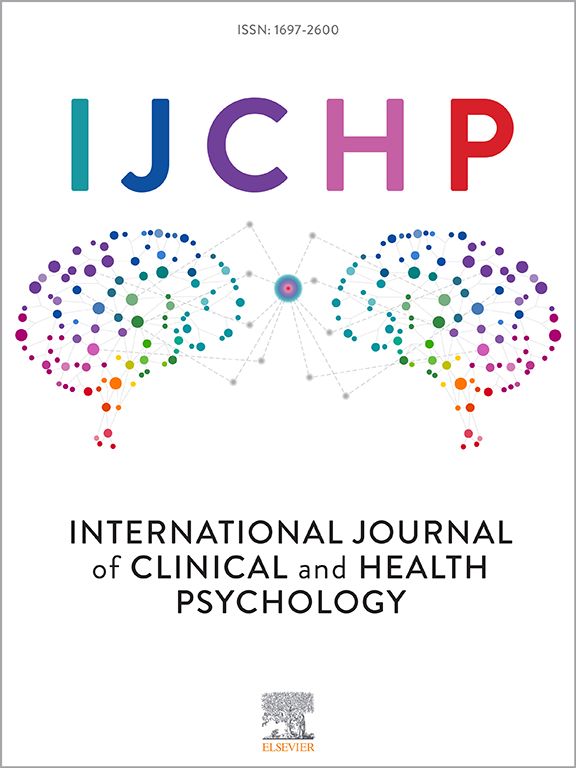Lower functional connectivity state transitions during affective processing correlate with subsequent impairment in sustaining positive affect in subthreshold depression
IF 4.4
1区 心理学
Q1 PSYCHOLOGY, CLINICAL
International Journal of Clinical and Health Psychology
Pub Date : 2025-01-01
DOI:10.1016/j.ijchp.2025.100560
引用次数: 0
Abstract
Background
Diminished capacity for maintaining positive affect (PA) has been identified in subthreshold depression (StD). While recent studies have explored affective dynamics among StD, the relationship between early emotional processing impairments and the capacity to prolong PA remains uncertain. Furthermore, it is unclear how brain connectivity patterns observed in StD are associated with PA maintenance.
Methods
The experimental procedure comprised a baseline rs-fMRI scan, followed by a PA-inducing movie viewing task, and three further rs-fMRI sessions. Participants provided PA ratings following each session. PA maintenance was quantified through the slope of mood change between each session after movie viewing. We performed a dynamic functional connectivity analysis on movie viewing data, as well as a series of static functional connectivity (FC), analyses on data of all rs-fMRI sessions from 25 StD and 25 healthy controls (HC). Correlations between brain-related measures and slope of mood change were calculated.
Results
Individuals with StD exhibited reduced capacity in sustaining PA, reflected in a decrease in PA in the early maintenance stage. StD also had a lower number of transitions between four brain states during movie viewing, which was related to subsequent impairment in sustaining PA. In addition, StD had weaker static FC between left inferior frontal gyrus and right middle occipital gyrus during the first resting-state session following movie viewing, which in turn was related to a steeper decline in PA.
Conclusions
These results highlight the brain features driving PA dysregulation in StD and provide a potential avenue for the development of future interventions.
在阈下抑郁症中,情感加工过程中较低的功能连接状态转换与随后维持积极情绪的损害相关
背景:阈下抑郁(StD)患者维持积极情绪(PA)的能力下降。虽然最近的研究探索了性病患者的情感动态,但早期情绪处理障碍与延长PA能力之间的关系仍不确定。此外,尚不清楚在性病中观察到的大脑连接模式如何与PA维持相关。方法实验过程包括一个基线磁共振成像扫描,随后是一个诱发pa的电影观看任务,以及三个进一步的磁共振成像会话。参与者在每次会议后提供了PA评级。通过观看电影后每次会话之间情绪变化的斜率来量化PA维持。我们对电影观看数据进行了动态功能连接分析,并对25名性病患者和25名健康对照(HC)的所有rs-fMRI数据进行了一系列静态功能连接(FC)分析。计算大脑相关测量与情绪变化斜率之间的相关性。结果性病患者维持PA的能力下降,表现为维持早期PA的下降。在观看电影期间,性病患者在四种大脑状态之间的转换次数也较少,这与随后维持PA的损害有关。此外,在观看电影后的第一个静息状态中,StD在左侧额下回和右侧枕中回之间的静态FC较弱,这反过来又与PA的急剧下降有关。结论这些结果强调了在性病中驱动PA失调的大脑特征,并为未来干预措施的发展提供了潜在的途径。
本文章由计算机程序翻译,如有差异,请以英文原文为准。
求助全文
约1分钟内获得全文
求助全文
来源期刊

International Journal of Clinical and Health Psychology
PSYCHOLOGY, CLINICAL-
CiteScore
10.70
自引率
5.70%
发文量
38
审稿时长
33 days
期刊介绍:
The International Journal of Clinical and Health Psychology is dedicated to publishing manuscripts with a strong emphasis on both basic and applied research, encompassing experimental, clinical, and theoretical contributions that advance the fields of Clinical and Health Psychology. With a focus on four core domains—clinical psychology and psychotherapy, psychopathology, health psychology, and clinical neurosciences—the IJCHP seeks to provide a comprehensive platform for scholarly discourse and innovation. The journal accepts Original Articles (empirical studies) and Review Articles. Manuscripts submitted to IJCHP should be original and not previously published or under consideration elsewhere. All signing authors must unanimously agree on the submitted version of the manuscript. By submitting their work, authors agree to transfer their copyrights to the Journal for the duration of the editorial process.
 求助内容:
求助内容: 应助结果提醒方式:
应助结果提醒方式:


